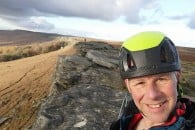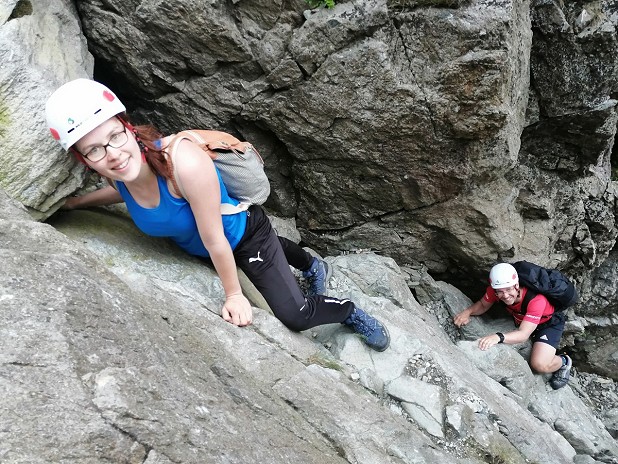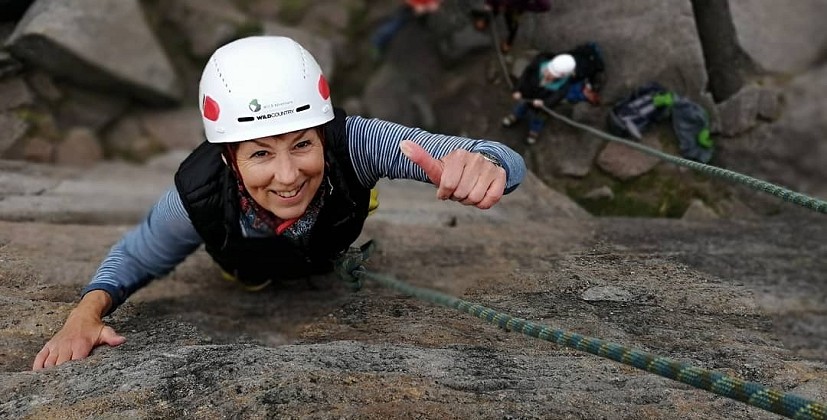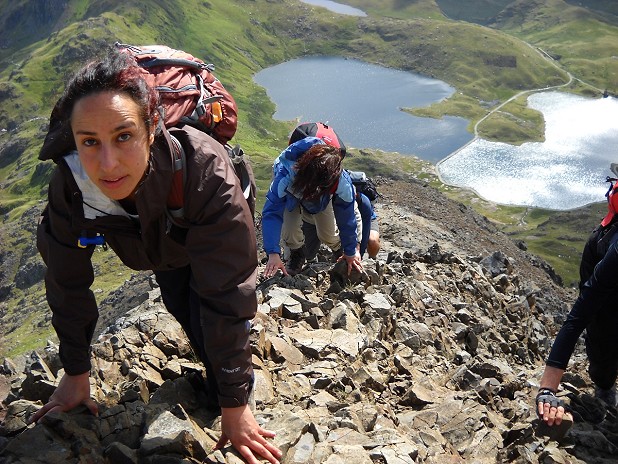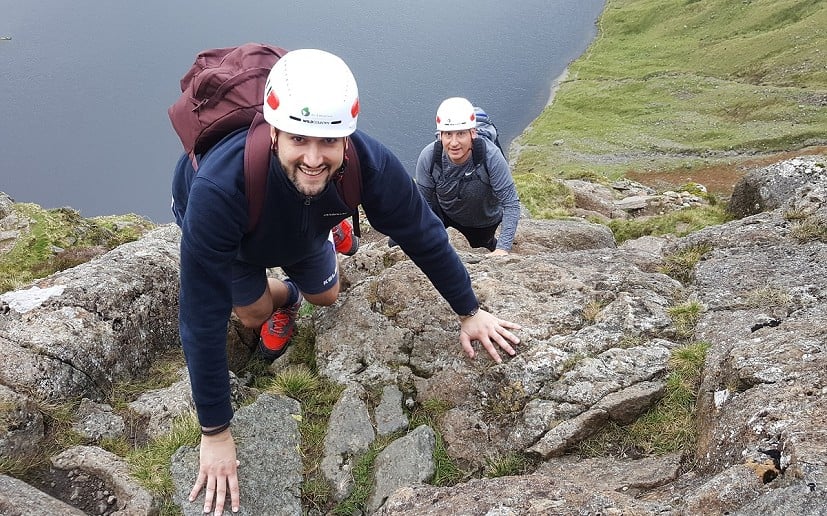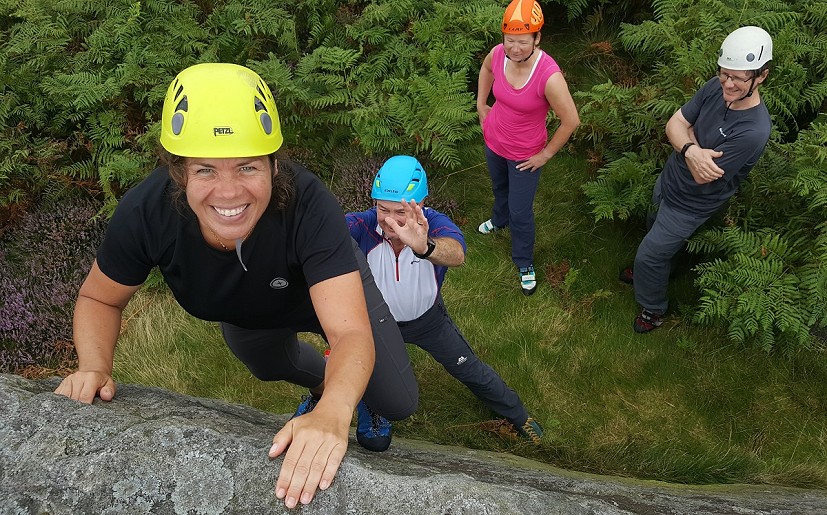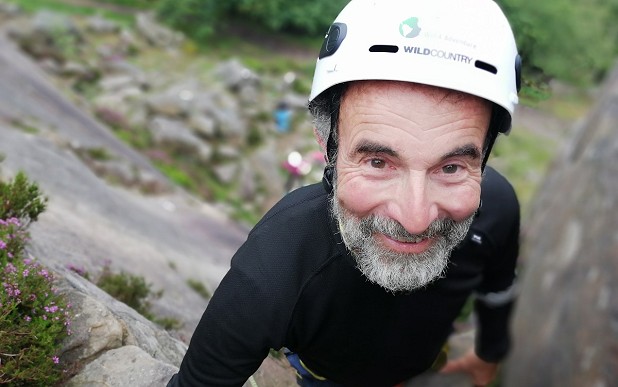Scramblers - Learn to Manage a Fear of Heights
Is a fear of heights holding back your scrambling progress? It's healthy to be wary, but not if you panic or freeze. Perhaps you aspire to some classic hands-on routes, but don't feel ready to trust yourself? Will Legon describes some clever ways to reprogram your fear response and help the rational you regain control...
For years, as a climber, I was held back by panicking pretty much the moment I was a metre or two above the ground. Perhaps my fear kept me alive, but even as I learned more about how I should be doing things safely, my cowardly head still kept talking me out of it. I desperately wanted the adventure, but couldn't actually face the reality!
Visualise yourself doing stuff that you really want to do. Start to see that it really is a possibility
Over the years I have made it a goal to no longer let my head ruin my adventures. Here's what works for me:
The psychological brain
Professor Steve Peters' book, The Chimp Paradox, focuses on three parts of the brain: the limbic, the frontal and the parietal. For the reader he calls these the chimp, the human and the computer (he accepts that this is a huge simplification of the psychological mind - but I find it works well for me, the layperson).
The chimp is the emotional part of the brain. It responds to stimuli faster than the human, and it is the more dominant of the two. The human is the rational, logical part of the brain that can think things through and come to a more objective conclusion for any stimuli or information presented to it. The computer enables us to do things automatically: everyday actions such as walking, driving a car or putting on your clothes (which Peters describes as auto-pilots). The computer also banks information on how we have dealt with past situations or stimuli, giving a reference point for either the chimp or the human to refer to.
How we read the world around us
The stimuli of how we read the world around us come through our senses, and largely these will be visual, audio and/or kinaesthetic. A visual stimulus is what you see, real or imagined. The audio is what you hear, including your inner voice (telling you not to carry on maybe). It could also be the sound of a howling gale, reminding you that these are serious weather conditions. The kinaesthetic is how we physically relate to the world around us. It might be the awkward slope of the hillside we're stood upon or the slippery nature of wet shiny rock feeding us information that we're not in a safe or secure place.
The amygdala is the part of your brain which controls emotions. When you're on the edge and fearing for your life it's this acorn-sized bit of your brain that's doing the work, but it's your cerebral cortex, the rational thinking part, that needs to be
When we are presented with a stimulus, our chimp is the part of the brain that manages this information first. It will need to make a decision as to which part of the brain is best placed to deal with any given stimulus. For example someone you know waves at you from across the street; the chimp may ask "computer, that's a friend waving at us, what do we do?" and the computer, on auto-pilot now, is already responding to the stimulus in micro-seconds by making you wave back.
The stimulus might be something very new however. For example, as you navigate down a path in a foreign, tropical country a large lizard-like creature presents itself. The chimp may then engage in a conversation with the computer and/or the human before it works out a plan. It's also on the cusp of allowing the amygdala (which is an integral part of the chimp) to take over.
Amygdala hijack
The amygdala, which is about the size of an acorn, is even poorer at thinking things through than the chimp. However it is really good at dealing with fight, flight, freeze situations.
If for example, you're driving at speed along the motorway, and the car in front suddenly brakes, when you see those brake lights getting rapidly larger as you approach the tail-end of that car, your amygdala takes over. This is called amygdala hijack. The amygdala physically takes the lion's share of oxygenated blood supply from the rest of the brain, and literally takes over. In a split second it will pump the body full of adrenaline, raise the heart rate and issue orders: "Pump the brakes! Turn left! Straighten up! Brake some more! Look for space!" and so on.
Once you have survived the encounter, the chimp thanks the amygdala for its life-saving actions, and then the computer stores the memory in case of need in the future.
A bit more on the computer
It's efficient for our brains to learn how to do things automatically since that way we can do more than one thing at once. So, when children are growing up, they learn things like how to walk, or how to throw and catch a ball etc whilst at the same time breathing, talking, laughing and a myriad of other things that we take for granted. As they practice these actions, and repeat them, they are sending signals up and down their body to the brain and thus creating neural pathways to make the actions automatic. The same is true of our patterns of behaviour.
Just outside the edge of your comfort zone is where you will start making progress
So if every time we are faced with what we perceive to be a scary stimulus, and we stop, have a moment of panic and then retreat, what we are doing is strengthening those neural pathways, and making this behaviour-set happen more readily and naturally in the future. That is why, unless we address these issues, they will continue to dominate our actions.
Develop an awareness of your chimp
Reflect at the end of each day, and consider when your chimp would have been ruling your actions. Minor road-rage in your car? How you were unduly hurt by someone's ill-considered words? Retreating off a climb you know you can do? Learn to recognise when your chimp is acting up.
In his book, Peters talks about managing the chimp by exercising it, boxing it and offering bananas. By this he means that you should allow your chimp to express itself appropriately. Don't try to deny its existence: let it talk. By boxing it, he means be prepared to debate with it, feed it reasoned facts and truth to counter its emotional dialogue. And finally be prepared to distract it from time to time, or reward it. In essence, be aware of this part to your brain, and in those calm moments of your life, allow time to reason with it.
Now start to visualise yourself doing stuff that you really want to do - a classic scramble, for instance.
Start to anticipate how you might be able to behave differently in future
What triggers your fear response? For a walker it might be walking towards an edge, or along a ridge-line. For a climber this might be as you climb above your last bit of gear. What do you do in these situations?
Is this a learned sequence that the brain's computer now has on autopilot? With a greater awareness of how and when your chimp can rule your actions, you are better placed to arrest this sequence of events somehow, the next time it starts to occur. You need to stop that amygdala taking over.
Stop the amygdala hijacking the brain – do some hard sums
The amygdala is only small, and while it's good at making you do something quick in order to survive, it is no good at thinking things through. The frontal lobes of your brain (which form the 'human') are the thinking, clever, rational part of your brain. This is the part of your brain you want to be doing the thinking in order to stop that flow of panic.
However, as your chimp starts to get over-excited it hogs all the oxygenated blood. To release the chimp's grip of you and to make the frontal lobes work instead, try to solve a hard task, like reciting your phone number backwards. The amygdala is too small to do this. It's like asking a ZX81 home computer from the 1980s to do the job of a modern smart phone: it just can't. Eventually it gives up and sends this harmless problem to the frontal lobes, which then allows you to start processing information more rationally.
Anticipate, act, repeat
Just outside the edge of your comfort zone is where you will start making progress. Obviously for different people that's in different places. What you need to do (now) is write a bucket list of objectives that you want to achieve.
Go out and do something you know will challenge your chimp. When it starts to flare up, simply stop. Acknowledge what's happening. Say your phone number backwards out loud and breathe. Ask yourself if maybe you might go on just a little bit further. At some point, you may have to stop and turn back, but you will have disrupted the pattern, and started to rewrite your script by your design! Reflect on how this can be the new you.
Once again, visualise yourself doing stuff that you really want to do. Start to see that it really is a possibility.
Go out, and repeat this all again on another day. See how far you get.
And breathe
Typically people hold their breath or hyper-ventilate when they are in a state of panic. When they are relaxed, their breathing is relaxed too. Breathe, and try to breathe in a relaxed way. This is another way to send a kinaesthetic stimulus to your brain that all is well.
And if it all goes wrong..?
You will still have your moments. If you do have a panic out there, manage the situation as follows:
Remember the amygdala is the small part of your brain which controls emotions, the fight or flight response (fear) and impulsive behaviour. When you're on the edge and fearing for your life it's this acorn-sized bit of your brain that's doing the work … but it's your cerebral cortex (the clever, rational thinking part) that needs to be.
1. Start breathing – stop holding your breath (you will be). Take TEN deep breaths. Count them in and out.
2. Distract your brain, start forcing it to think. You really really must do this. For example say out loud your mobile phone number in reverse. This will help to engage your rational thinking cerebral cortex, and this will begin to calm you down.
3. Visualise someone you know (or James Bond for me) who is really confident with heights – pretend you are them in this exact situation (I hum the James Bond tune too, which also helps keep my cerebral cortex working).
4. Visualise yourself at the top or at the next safe place and see how much nicer that will be for you. When you get to that spot, acknowledge that you managed it once, you can manage it again.
5. Keep that cortex working – tell yourself your mobile phone number in reverse again. Keep breathing.
6. Thinking head now engaged – start thinking and looking. Break this challenge down into small chunks. This might start by just letting go with one hand at a time, maybe dropping your heels or just taking a single step. Keep breathing.
7. Once out of immediate trouble, take the time to plan each step to the next safe platform.
The future
A lifetime of programming your brain to behave in the way it does takes a journey to undo, so do not expect changes in yourself to be a light switch moment. But you can definitely turn things around for yourself.
From here on promote positive expectations for yourself. Be positive in the way you regard and describe yourself. Stop telling people that you are afraid of heights. Pessimists think bad things are forever. Be an optimist, accept bad things as temporary setbacks and accept that these will occur within the wider scope of life. There will be blips on this journey when you have a bad day out, but you won't always have a bad day. Stay positive and you will know that the good achievements will continue.
Good luck with the journey!
About Will Legon
Will Legon of Will4Adventure works professionally in the outdoors as a mountain leader and a climbing instructor. As well as rock climbing corses and guided scrambling, Will runs a popular course called Overcome Your Fear of Heights
